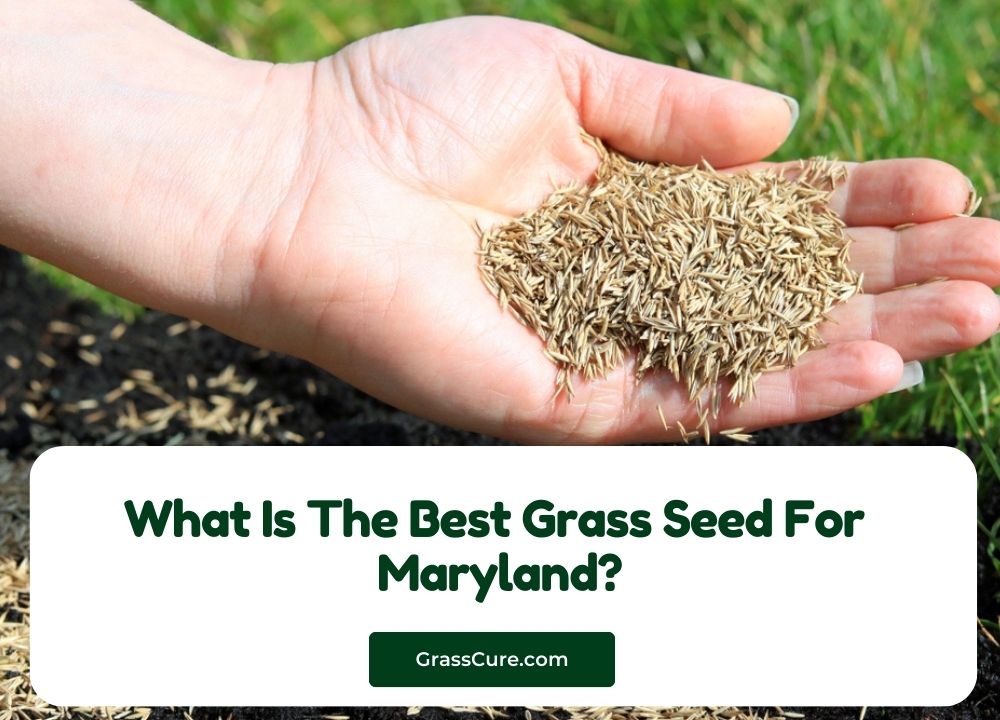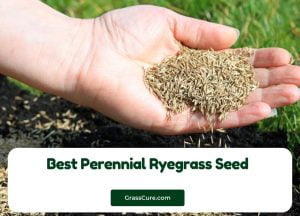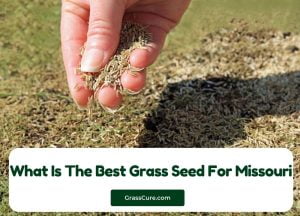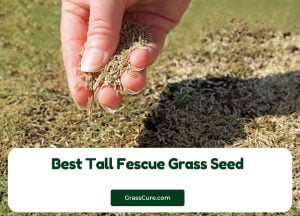When it comes to achieving a lush and vibrant lawn in Maryland, selecting the right grass seed is the cornerstone of success. Maryland’s diverse climate, with its hot and humid summers, as well as chilly winters, demands a specific blend of grass varieties to ensure a year-round green carpet.
In this blog post, we’ll explore the best grass seed options tailored to Maryland’s unique climate and soil conditions. Whether you’re looking for resilient grass that can withstand heavy foot traffic or a variety that thrives in the shade, we’ll guide you through the top choices to help you create the perfect lawn for your Maryland property.
The best grass seed for Maryland usually consists of bluegrass, ryegrass, tall and fine fescue, or any mixture of these herbs. The main focus is the use of grass seeds that are drought-resistant. Some people use Zoysia japonica in Maryland. This is a warm-season herb that hibernates and turns brown during each cold month in the Maryland winter (about six months).
Contents
Cold Season Grass:
Tall Fescue:
The new Tall Fescue lawn is very suitable for Maryland. It is a tough herb, so it takes time to recover and recover, but it is very durable. Resistant to drought, high temperatures, and salt. It has some resistance to shade
Tall fescue is a popular choice for Maryland lawns, and for good reason. This cool-season grass variety offers exceptional adaptability to the state’s climate, making it one of the best grass seed options for Maryland. Its deep-rooted nature allows it to withstand both the scorching heat of summer and the cold winters.
Tall fescue is known for its durability, making it an ideal pick for high-traffic areas. It can handle wear and tear without losing its vibrant green color. Additionally, its tolerance to drought and resistance to diseases common in Maryland make it a reliable choice for homeowners seeking a low-maintenance lawn.
Whether you have a family that loves to play in the yard or you want a lawn that stays green throughout the seasons, tall fescue is a top contender for the best grass seed for Maryland lawns.
Check Best Tall Fescue Grass Seed
Kentucky Bluegrass:
This high-quality lawn has a great green color and excellent elasticity. However, it usually has easy damage from heat exposure and drought, requires moderately high maintenance, is prone to straw, is susceptible to many diseases, and is not resistant to shade and salt.
Kentucky Bluegrass is another excellent option when considering the best grass seed for Maryland lawns. This cool-season grass variety is renowned for its lush, fine texture and rich green color, adding a touch of elegance to your landscape.
Kentucky Bluegrass thrives in the temperate climate of Maryland, particularly in areas with well-draining soil and sufficient sunlight. It creates a dense and uniform lawn that’s perfect for residential properties. While it may not be as drought-tolerant as tall fescue, proper irrigation and care can result in a stunning, velvety lawn.
This grass variety is a fantastic choice for homeowners who prioritize a visually appealing, manicured lawn and are willing to put in the effort to maintain it. With its aesthetic appeal and adaptability to Maryland’s climate, Kentucky Bluegrass is a strong contender in the quest for the perfect grass seed.
Check Best Kentucky Bluegrass Grass Seed
Perennial Ryegrass’s
It harvests from the grass during the colder months. These grasses are compatible with bluegrass in appearance, do not form straw, have excellent heat resistance, and are resistant to drought. They are often susceptible to disease and become less resistant to frost when flooded or exposed to the wind.
Perennial ryegrass exposes to sunlight but can resist shade. The ryegrass is carefully cultivated for a pleasant dark green color, excellent texture, and superior cut quality. It is also ideal for mixing with Kentucky Glass and Premium Fesk.
Check Best Perennial Ryegrass Seed
Fine-leaf fescues:
Fine-leaf fescues, including varieties such as creeping red fescue and chewings fescue, are often chosen for specific lawn requirements in Maryland. These grasses are characterized by their slender and fine-textured blades, which lend a delicate, ornamental appearance to the lawn.
Fine-leaf fescues excel in shaded areas, making them a great choice for Maryland yards with ample tree cover. They are shade-tolerant, thrive in cooler climates, and require less maintenance than some other grass varieties. While they might not withstand heavy foot traffic as well as tall fescue or Kentucky bluegrass, they are perfect for creating a lush, green carpet in areas where sunlight is limited.
For homeowners who have shaded portions of their lawns and value a graceful, low-maintenance aesthetic, fine-leaf fescues can be a valuable addition to the mix of grass seeds in Maryland.
Summer grass:
Zoysiagrass:
This is the only hot-season grass grown in Maryland. Zoysiagrass is easy to identify because it leaves you with stiff hair. It remains brown until spring and turns brown again during the first autumn frost.
Zoysiagrass is highly invasive and is usually the bone of a conflict between neighbors. The only logical place for zoysiagrass is the beach house, which can only be seen in the summer.
Step by Step guide on planting the best grass seed for Maryland
Prepare the lawn by removing the plants and using a farmer to dig the soil 20 to 20 centimeters deep. Use a grass roller filled with water to compress the soil and increase its weight.
Apply 1: 2: 1 fertilizer to the soil surface. Make sure that the actual fertilizer does not contain herbicides, as it will prevent seed growth. Do not fertilize the soil.
Use a spreader to sow half the grass seeds and sow in a north-south direction. Sow the next half of the seeds in an east-west direction. This will ensure that the lawn area is full of seeds.
After sowing, lightly spread the seeds so that they sink into the 1/8 inch soil. Roll a half-full area under a rolling pin to gain weight and keep the seeds in place.
Immediately after sowing, water the plantation to moisten the soil and allow germination. It prevents the dirt from drying out during germination. During the first 3-4 weeks of growth, spray more water twice a day for 10-20 minutes.
During the germination process, the lawn is full of seedless straw mulch to retain moisture. After 2-3 weeks of growth, remove the cap.
Follow the instructions on the package to apply the appropriate amount of grass seed. Most types of seeds contain 16 to 22 seeds per square inch of soil. When crossing the lawn twice, spread ten seeds per square inch.
Hydroseeding Watering Instructions
Hydraulic seeds create a new lawn that involves applying high pressure to a mixture of seeds, fertilizer, and water and coating it with shiny green cellulose. Irrigation is an essential step, as irrigation continues throughout the growth process.
Initially, water several times a day to increase the germination rate. The green blanket covered should be moistened with a sponge. After the grass has germinated, reduce irrigation so that young plants breathe oxygen and take root as food. Finally, depending on the weather and climate, the grass is ready to be watered.
The first watering is done with hydrated seeds. A solution of water, water-soluble fertilizer, seeds, and cellulose is poured over the top of the soil to prepare for the new lawn’s growth. Wait 24 hours.
Water three times a day during sprouting to prevent the green blanket from turning yellow and drying out. Manual application takes time, but it can also be used. You can use a spray gun or a series of sprinklers designed to keep the entire sponge moist. Spread some cans of tuna on the lawn and see how much water is being loaded. The color of the blanket indicates that it is not dirty enough. Aim for uniform saturation to maximize seed sprouting.
Watering Frequency
Reduce the watering frequency after the grass has sprouted for 2 to 3 weeks. Drink water once a day. Moreover, putting one inch of water on the lawn daily increases the available oxygen and forces the plant’s roots to germinate deeply into the food. Continue the actual watering daily for the next few weeks until the lawn is ready to be watered.
Some Related FAQ
Q: What is the best time to plant grass seed in Maryland?
A: The ideal time for planting grass seed in Maryland is during the early fall, typically between late August and early October. The soil is warm, and there is usually more consistent rainfall during this period, creating optimal conditions for seed germination and root development.
Q: How often should I water my newly seeded lawn?
A: In the initial stages after seeding, it’s important to keep the soil consistently moist. Water the area lightly at least once a day, or more often if the weather is particularly hot and dry. As the grass begins to establish itself, you can gradually reduce the frequency of watering.
Q: Which grass seed type is best for a high-traffic area in Maryland?
A: Tall fescue is an excellent choice for high-traffic areas in Maryland. It’s known for its durability and resilience, making it well-suited for lawns that receive frequent use.
Q: What should I do to prepare the soil before planting grass seed?
A: To prepare the soil, start by removing any weeds, rocks, or debris. Then, loosen the soil to a depth of about 2-3 inches, either by tilling or using a lawn aerator. Finally, add a layer of quality topsoil or compost to improve soil structure and fertility.
Q: How long does it typically take for grass seed to germinate in Maryland?
A: Germination time can vary depending on factors like grass type, weather, and soil conditions. In Maryland, it usually takes 7 to 14 days for grass seed to germinate, although some varieties may take longer.
Q: Should I fertilize my newly seeded lawn, and if so, when?
A: Fertilizing your newly seeded lawn can promote healthy growth. It’s best to wait until the grass has been mowed at least three times before applying a balanced, slow-release fertilizer. This often occurs about 6-8 weeks after seeding.
Q: Are there any grass seed blends specifically designed for Maryland’s climate?
A: Yes, you can find grass seed blends and mixtures that are formulated for the specific climate and conditions in Maryland. These blends often combine varieties like tall fescue, Kentucky bluegrass, and fine-leaf fescues to create a resilient, adaptable lawn that thrives in the state’s varying weather.
Conclusion
Depending on the weather and climatic conditions, water twice a week and combine rain with about 5 centimeters of water. Use water with care to prevent erosion of the lawn. The automatic irrigation system makes it easy to configure daily and weekly irrigation schedules. This is the best way to grow grass in Maryland.







